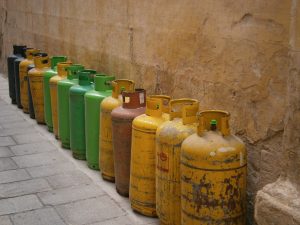Print a Sign-In Sheet | Spanish Version 
Due to the nature of gas cylinders, special storage and handling precautions are necessary. Some hazards associated with compressed gases include oxygen displacement, explosion hazards, the toxic effect of some gases, as well as the physical hazards of a ruptured cylinder.
A sudden release of gases can cause a cylinder to become a missile-like projectile, destroying everything in its path. Cylinders have been known to penetrate concrete-block walls. To prevent such a dangerous situation, there are several general procedures to follow for safe storage and handling of a compressed gas cylinder:
Identification of Contents of Compressed Gas Cylinders
The contents of any compressed gas cylinder should be identified clearly so as to be easily, quickly, and completely determined by any worker.
Transporting Gas Cylinders
- Cylinders transported must be fastened securely in an upright position so that they will not fall or strike each other.
- Cylinders must not be transported without safety caps. A cylinder’s cap should be screwed all the way down on the cylinder’s neck ring and should fit securely. Do not lift cylinders by the cap. The cap is for valve protection only.
- Cylinders should not be transported with the regulator attached to the cylinder.
Storage of Compressed Gas Cylinders
- Cylinders should not be allowed to drop nor be struck violently.
- Cylinders should be properly secured at all times whether attached to a wall, cylinder rack, or post.
- Caps used for valve protection should be kept on the cylinders at all times except when the cylinder is actually being used.
- Cylinders should be stored in a well-ventilated area away from flames, sparks, or any source of heat or ignition. Keep cylinders away from electrical circuits.
- Cylinders should not be exposed to an open flame or to any temperature above 125 degrees Fahrenheit.
- Oxygen cylinders (empty or full) in storage should be separated from fuel-gas cylinders and combustible materials by a minimum distance of 20 feet or by a barrier at least 5 feet high having a fire-resistance rating of at least one-half hour.
- Full and empty cylinders of all gases should be stored separately and identified by signs to prevent confusion.
Use of Compressed Gas Cylinders
- Know and understand the properties, uses, and safety precautions of the gas before using the cylinder.
- Always use the proper regulator for the gas in the cylinder. Always check the regulator before attaching it to a cylinder. If the connections do not fit together readily, the wrong regulator is being used.
- Before attaching cylinders to a connection, be sure that the threads on the cylinder and the connection mate are of a type intended for the gas service.
- Attach the regulator securely before opening the valve.
- Open cylinder valves SLOWLY.
- Stand to the side of the regulator when opening the cylinder valve.
- Do not attempt to repair cylinder valves or their relief devices while a cylinder contains gas pressure.
- Close valves on empty cylinders and mark the cylinder “empty”.
Things Not to Do:
- Never roll a cylinder to move it.
- Never carry a cylinder by the valve.
- Never leave an open cylinder unattended.
- Never leave a cylinder unsecured.
- Never force improper attachments on to the wrong cylinder.
- Never grease or oil the regulator, valve, or fittings.
- Never attempt to refill a cylinder.
- Never attempt to mix gases in a cylinder.
- Never discard pressurized cylinders in the normal trash.
Frequent MSHA/OSHA CYLINDER VIOLATIONS:
- Unsecured cylinders.
- Cylinders stored without protective caps.
- Noncompatible gases (such as hydrogen and oxygen) stored together.
KEMI does not assume liability for the content of information contained herein. Safety and health remain your responsibility. This information is to be used for informational purposes only and not intended to be exhaustive or a substitute for proper training, supervision or manufacturers’ instructions/recommendations. KEMI, by publication of this information, does not assume liability for damage or injury arising from reliance upon it. Compliance with this information is not a guarantee or warranty that you will be in conformity with any laws or regulations nor does it ensure the absolute safety of any person, place or object, including, but not limited to, you, your occupation, employees, customers or place of business.

